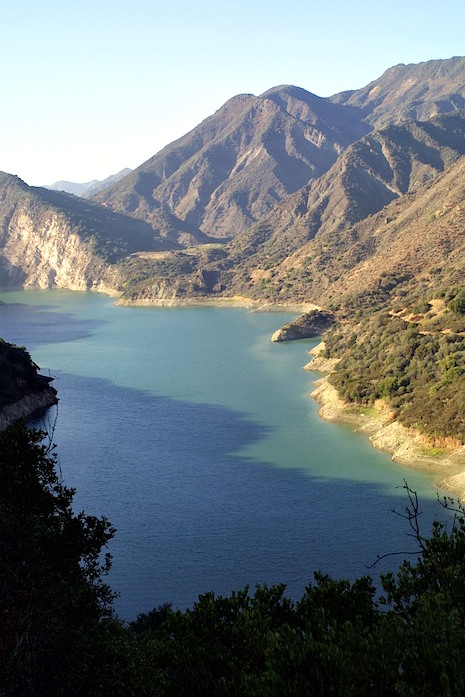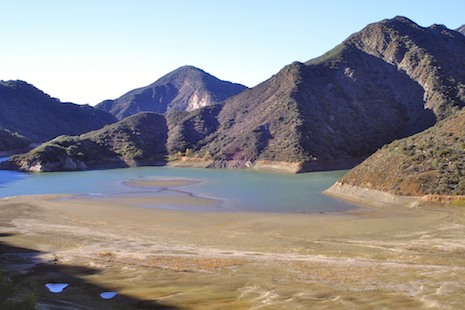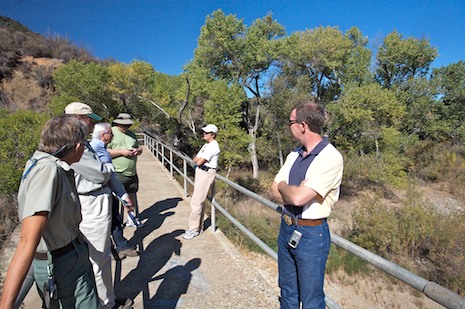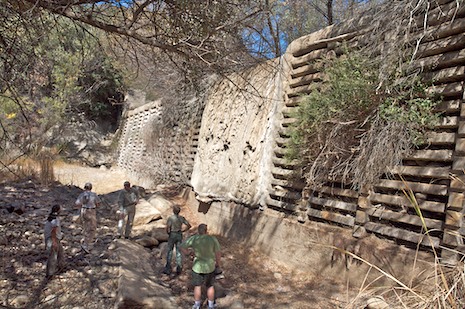Zaca Fire Impacts Drinking Water Treatment
City Confident Water Will Meet Strict Health Standards
Gibraltar Reservoir is full of water, the excess spilling over into the river below. The sun is out, it’s pleasantly warm and large bush lupine filled with beautiful blue flowers dot the hillsides. All seems well along the Santa Ynez River.
The water, however, tells a different story. I’ve joined several water experts from the City of Santa Barbara’s Public Works Department to take a close look at the impacts of the Zaca Fire on our water supply. There has been a fairly substantial amount of rain this year, something city officials had hoped might not occur, and now they are looking at ways of dealing with the after effects.

Dam Tender Ted Bachurin immediately puts things in perspective. “We had thirty inches of rain in January alone, he explains. “Using the depth finder on the lake boat, it looks like we added almost ten feet of sediment to the lake bottom.”
“The past three years we lost a total of a hundred acre feet of storage space,” Rebecca Bjork adds. She is acting Water Resources Manager and as such is responsible for managing the city’s water supply. “After this year’s rains we expect to lose an additional 3,000 acre feet.” Ted’s rough measurements seem to confirm this though the city won’t know exactly how much has been lost until more sophisticated tests are run in late summer.
For now, it isn’t the siltation that most concerns the water officials. “Look at the color of the water,” Bjork points out. “You can see the discoloration, that light yellow color. That tells me we’ve got quite a bit of dissolved organic material in the water.” These nutrients include phosphorous, nitrogen and carbon- materials that not only can cause algae blooms as the water temperatures begin to rise in Gibraltar or Lake Cachuma, but it also complicates efforts to remove them at Cater Treatment Plant.

“Dissolved nutrients are normally present in the water,” Bjork explains. “They are part of the plant decomposition process, but not in the amounts we’re seeing.” The Zaca Fire has short cut the process, vaporizing thousands of acres of chaparral and turning it into ash and small bits of charcoal that add dissolved materials into the water much like the way coffee grounds impart flavor to coffee. The impact to Cachuma, which supplies most of the South Coast’s water is not too much different than having dumped thousands of bags of fertilizer into the lake.
“This is the most challenging water I’ve had to treat in my 29 years with the City” says Susan Thomson, the City of Santa Barbara’s Water Treatment Superintendent. There are two issues. First is removing as much of the dissolved material as possible before it enters the distribution pipeline. This is done by adding granulated charcoal to the water, causing the dissolved materials to adhere to the surfaces of the larger particles. Other compounds are then used to settle these out.

Because the carbon is inert, there are no health issues involved in its use according to Bjork but there is a cost: big bucks. “This year we expect to spend close to $250,00 on the carbon treatment and next year $1.5 million,” she adds, “Normally we don’t typically add carbon to the treatment process so this is a cost to us well above what we’d normally pay to treat the water.” City officials are scrambling to see if they can get state grand funds to offset some of these costs.
The second issue involves what are known as disinfection by-products (DBPs). These are caused when chlorine, added to kill viruses and bacteria, reacts with the dissolved organic material that still remains in the water. Currently, the water meets the very strict standards set by the EPA but as water temperatures warm up there is a possibility the city could exceed EPA standards for short periods of time in later summer.

“We’re hopeful that won’t happen,” Bjork adds. “EPA standards are set to protect public health from exposure over a long period of time In the case of water, drinking 2 liters a day over a 70 year period of time] so if we exceed at all it’s likely to be for such a short period of time that the DPBs are not likely to be a serious problem. Nevertheless, we’ll notify the public if we do exceed those standards.”
What may be noticed most will be water taste and odor. Algae blooms in Cachuma caused by the increase in nutrients could cause what Bjork calls a “musty” taste and possibly a slightly unpleasant odor. Though not harmful, both could make city water even more difficult to swallow than ever.



